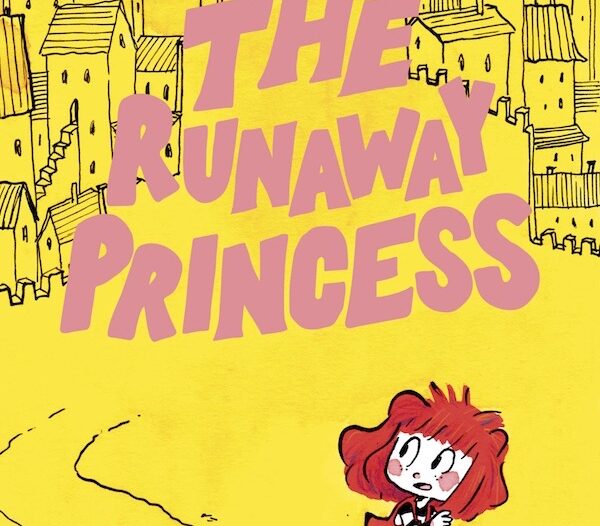
Review: ‘The Runaway Princess’

The Runaway Princess
Writer/artist: Johan Troïanowski
RH Graphic; $12.99
Princess Robin has a bad habit of leaving the safety of her castle and going off on adventures, sometimes by choice and sometimes by circumstances beyond her control. Although given that she is a comic book character, perhaps her repeated abandonment of the castle is a good habit, rather than a bad one; after all, would anyone really rather read a comic entitled The Princess Just Stays Put instead of one called The Runaway Princess?
The latter is, of course, the title of French cartoonist Johan Troïanowski’s new comic, his first to be republished in the United States and one of the first batch of offerings of publisher Penguin Random House’s extremely promising new comics imprint, RH Graphic. It is, in actuality, three different comics stories, featuring three different adventures of Princess Robin (each of which begins with a map displaying the environs in which the adventure will take place, as all good fantasy stories should).
ADVERTISEMENT
ADVERTISEMENT
Robin is a red-haired, red-dressed little girl who lives in a castle with her mother the queen, her father the king, and Elias, her tutor who is also a wizard. In the first story, Robin has runaway to visit the far off city of Noor for the annual Aquatic Carnival. The journey naturally entails a great deal of adventure, as she befriends a group of four brothers whose father abandoned them in the woods, is menaced by first a wolf and later a mud monster, meets a giant ogre and his little helpers (none of whom are what they seem), gets kidnapped, and gets lost quite a bit. Meanwhile, her mother, who can fly, and Elias, who takes a potion to make himself into a giant, go looking for her.
Troïanowski’s plotting flows like a dream, or, perhaps, the sort of story a little kid might tell (“And then this happened and then this happened and then…”), and it’s bursting with characters and elements evocative of fairy tales, nursery rhymes, and classic children’s stories like those of Lewis Carroll, L. Frank Baum, and J.M. Barrie.
Robin and the brothers, who remain her adventuring companions for the rest of the book, are all loosely designed and rendered, charmingly drawn moppets that are mostly expressive heads. Troïanowski’s watercolor-like coloring is luminously brilliant, like an electric rainbow, and the first adventure includes some incredibly inventive and visually complex scenes, particularly when Robin and friends get to the carnival, which is basically a riot of doodles come to life.
Upping the engagement factor even more, narration boxes will occasionally appear to solicit the help of the reader. This first occurs when Robin meets a wolf in the woods. “Dear reader, Robin needs you,” the first of these reads. “To help her escape the wolfs’s clutches, close the book, shake it up and down three times, and then turn to the next page.”
Doing so will reveal that the menacing trees that were closing in all around Robin have now tumbled like dominoes, little clouds of dust rising from them, and the wolf is buried somewhere underneath them, leaving a shaken-up Robin free to escape before the knocked-out wolf can awake.
Often these participation passages will be more complex, consisting of mazes for the reader to help Robin and friends navigate, or a prescribed pattern of lily pads that are safe to jump on to be figured out, or, the first story’s most complicated sequence, helping Robin’s mother follow the conflicting directions she gets from the people of Noor to find the Aquatic Carnival.
ADVERTISEMENT
ADVERTISEMENT
The first story, “The Princess Runs Away (And Makes Some Friends),” is followed by “The Princess Runs Away Again (By Accident This Time)” and “The Princess Tries To Stay In One Place (But The Weather Doesn’t Cooperate).”
In the second story, the brothers spend the night at Robin’s castle, and a new adventure begins when she is lured into a well by mysterious music. In the underground Kingdom of Darkness, Robin meets a lonely little girl named Plum who wants to play with her, but who is, in actuality, The Autumn Witch, and the witch needs to eat a princess in order to restore her full magical powers. The brothers mount a daring rescue attempt, and both parties engage in similar dream-like, stream-of-consciousness adventures full of familiar-feeling aspects, as in the first story.
Then, in the third, the kids are playing on an abandoned boat in the middle of a field, which seems safe enough until a powerful storm hits, hurling the little ship through the air until it alights in a tree on a far-away island, an island filled with new characters, creatures and, dangers, like pirates who sail the seas in a gigantic ship in a bottle.
Troïanowski’s Runaway Princess seems to be set in the collective unconsciousness, but more noteworthy than his inspired and highly imaginative world-building or even his considerable cartooning is the strength of the characters he created. Regardless of whether Princess Robin goes looking for adventures or the adventures find her, readers will be glad to join Robin and the four brothers on them, and lend a hand where they can.
About J. Caleb Mozzocco
J. Caleb Mozzocco is a way-too-busy freelance writer who has written about comics for online and print venues for a rather long time now. He currently contributes to Comic Book Resources' Robot 6 blog and ComicsAlliance, and maintains his own daily-ish blog at EveryDayIsLikeWednesday.blogspot.com. He lives in northeast Ohio, where he works as a circulation clerk at a public library by day.
ADVERTISEMENT
ADVERTISEMENT
SLJ Blog Network
2024 Books from Coretta Scott King Winners
The Ultimate Love Letter to the King of Fruits: We’re Talking Mango Memories with Sita Singh
Parsing Religion in Public Schools
Finding Answers to a Not-So-Simple Question, a guest post by Christina Matula
ADVERTISEMENT







